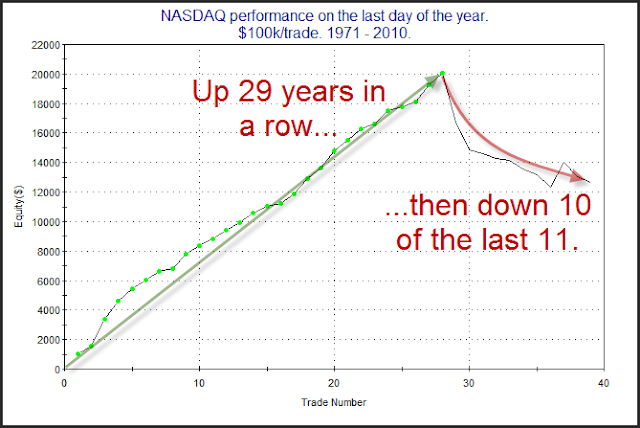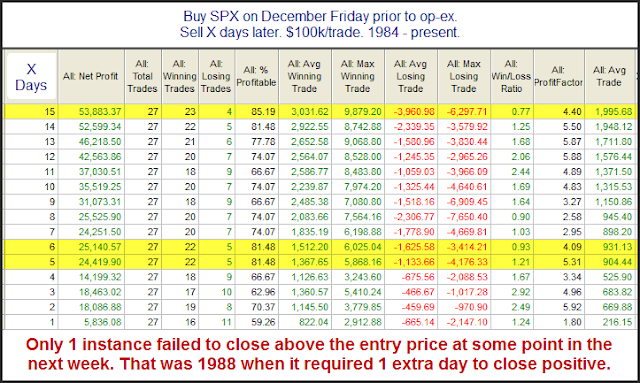I’ve updated the Quantifiable Edges Big Time Swing System overview page with results through December 28th. There is not a SPY trade currently open and based on the current market setup there is no chance of a trade triggering before year-end. I don’t update results that often since the system only trades about once per month on average.
The 2nd half of 2011 was a somewhat difficult period for those using the system to trade SPY. In August SPY suffered the worst losing trade in its history after it triggered long shortly before the US debt downgrade and market collapse. This 1 trade alone was responsible for an 8.26% loss. But even with the loss the Quantifiable Edges Big Time Swing System managed to finish the year with a small 0.25% gain for SPY traders (including dividends, commissions, interest, and compounding assumptions). This was certainly disappointing but in a tough year for the market, and with the SPY suffering it’s worst drawdown ever, it was nice to be able to finish in the black.
Traders who used the standard parameters and traded any of the other 29 ETFs that I discussed in the manual and have tracked for the last several years likely made out much better than this. Including SPY, the average return of the 30 ETFs was 11.54% and the median was 9.65%% (see assumptions in table). If you want to see stats for the full history of the 30 ETFs, that can be found on the
Quantifiable Edges Big Time Swing overview page. I have listed 2011 trading results for all 30 ETFs in the table below.
You may have noticed that SPY shows a gain of just over 1% here. The disparity between this 1% gain and the 0.25% gain shown on the overview page is primarily the dividends that had to be paid on short positions and the fact that it had to overcome a drawdown. Most of the time the "raw" returns here will understate the compounded results. That isn't the case this year for SPY.
As you can see, EEM was the star in 2011. It has done extremely well over the last 5 years. This is the 3rd year in the last 5 that is has returned over 33%, and all 5 years it gained better than 12.5%. This isn’t typical, though. EEM has been an especially strong performer.
For those looking for a system that they can use as a base to build their own system from, the Big Time Swing is an attractive option. It is all open-coded and comes complete with a substantial amount of background historical research. And since it is only in the market about ¼ of the time, it can easily be combined with other systems to provide greater efficiency of capital. Once you’re ready to try and improve the system yourself you can also refer to the system manual or the August 2010 purchaser-only webinar – both of which discuss numerous ideas for customization.
And if system development isn’t your thing, the Big Time Swing System provides easy to follow mechanical rules that you can follow. The standard parameters have performed quite well. There are only about 12 trades per year averaging 7 trading days per trade. All entries and exits are either at the open or the close. And to be sure you have everything set up properly traders may follow the private-purchasers only blog that shows all SPY signals and possible entry/exit levels. This service is free for 12 months from the date of purchase.
For more information and to see the updated overview sheet,
click here.
If you’d like additional information about the system, or have questions, you may email BigTimeSwing @ Quantifiable Edges.com (no spaces).




















































